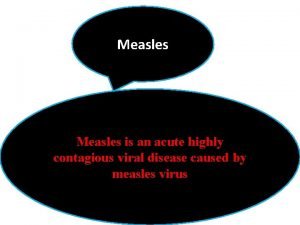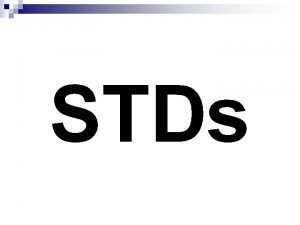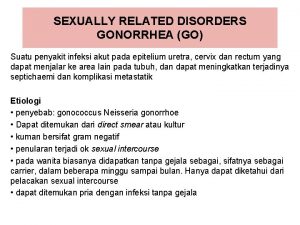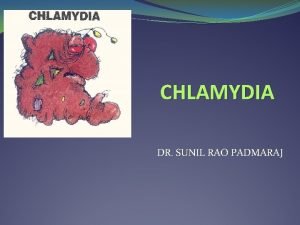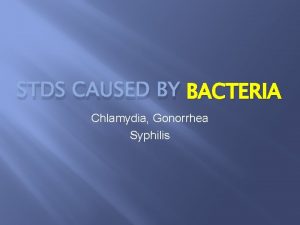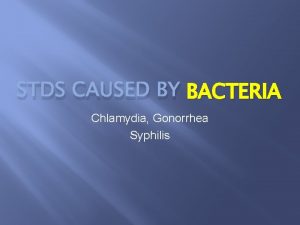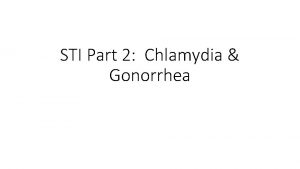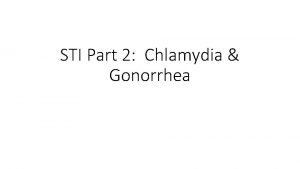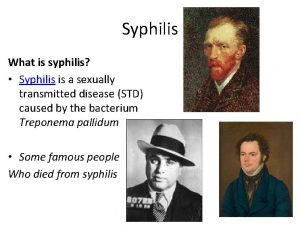New Cases Chlamydia Gonorrhea Syphilis HIV Acute Viral





















- Slides: 21

New Cases: Chlamydia, Gonorrhea, Syphilis, HIV, Acute Viral Hepatitis A, B, and C, and Tuberculosis

NCHHSTP Atlas National Center for HIV/AIDS, Viral Hepatitis, STD and TB Prevention The NCHHSTP Atlas is an online, interactive tool that gives you the power to analyze, map, and create tables using HIV, STD, viral hepatitis, and TB data that are reported to CDC. Using the NCHHSTP Atlas, you can: • Create custom maps and bar graphs using HIV, STD, viral hepatitis, or TB data (NCHHSTP Atlas has 15 disease variables to explore); • Compare two or more diseases (e. g. , HIV and TB); • Explore data by population groups and categories (e. g. , by race, age group or sex); • Display changes over time and patterns across the United States (NCHHSTP Atlas has 15 years of data for most variables); • Examine multiple areas (e. g. , VA, MD, and DC); and, • Download data and export graphics. The NCHHSTP Atlas website also provides the most recent data on poverty, education and other important measures of social determinants of health that are important to NCHHSTP’s mission.





Primary and Secondary Syphilis (2014) All races/ethnicities | Both sexes | Change over time (2000 -2014) | All age groups | By State Legend classified using quantiles according to 2000 -2014 data. National Data By Year Disclaimer: This is a user-generated report. The findings and conclusions are those of the user and do not necessarily represent the views of the CDC. Data Source: The Atlas presents chlamydia, gonorrhea, congenital syphilis, and primary & secondary syphilis case report data for 2000 to 2014 and early latent syphilis case report data for 2003 -2014. Data consist of case count or rate per 100, 000 by disease, year of diagnosis, reporting area (state or territory), age group, race/ethnicity, and sex. For more information, see: Interpreting STD Surveillance Data. Notes: Cases of a given STD refer to confirmed diagnoses during a given time period. Rates per 100, 000 population were calculated for each STD using U. S. Census Bureau population estimates. Race/ethnicity data are provided for states reporting in 1997 Office of Management and Budget (OMB) race standards. Race/ethnicity trend data are provided for states reporting in the 1997 OMB standard for at least 5 years. Natality data from the National Center for Health Statistics are used to calculate congenital syphilis rates. Cell suppression: CDC follows the 1996 CSTE data re-release rules for STD data. For state-level analysis, data are suppressed when the numerator for a given state is 3 or less. When suppressed, data are only available as state totals and no demographic data are shown. For more info, see: Interpreting STD Surveillance Data Suggested citation: NCHHSTP Atlas. Accessed on 02/03/2016.

Primary and Secondary Syphilis (2014) All races/ethnicities | Both sexes | Change over time (2000 -2014) | All age groups | By County Legend classified using quantiles according to 2000 -2014 data. National Data By Year Disclaimer: This is a user-generated report. The findings and conclusions are those of the user and do not necessarily represent the views of the CDC. Data Source: The Atlas presents chlamydia, gonorrhea, congenital syphilis, and primary & secondary syphilis case report data for 2000 to 2014 and early latent syphilis case report data for 2003 -2014. Data consist of case count or rate per 100, 000 by disease, year of diagnosis, reporting area (state or territory), age group, race/ethnicity, and sex. For more information, see: Interpreting STD Surveillance Data. Notes: Cases of a given STD refer to confirmed diagnoses during a given time period. Rates per 100, 000 population were calculated for each STD using U. S. Census Bureau population estimates. Race/ethnicity data are provided for states reporting in 1997 Office of Management and Budget (OMB) race standards. Race/ethnicity trend data are provided for states reporting in the 1997 OMB standard for at least 5 years. Natality data from the National Center for Health Statistics are used to calculate congenital syphilis rates. Cell suppression: CDC follows the 1996 CSTE data re-release rules for STD data. For state-level analysis, data are suppressed when the numerator for a given state is 3 or less. When suppressed, data are only available as state totals and no demographic data are shown. For more info, see: Interpreting STD Surveillance Data Suggested citation: NCHHSTP Atlas. Accessed on 02/03/2016.

Early Latent Syphilis (2014) All races/ethnicities | Both sexes | 2014 | All age groups | By State Legend classified using quantiles according to 2014 data. National Data By Sex Disclaimer: This is a user-generated report. The findings and conclusions are those of the user and do not necessarily represent the views of the CDC. Data Source: The Atlas presents chlamydia, gonorrhea, congenital syphilis, and primary & secondary syphilis case report data for 2000 to 2013 and early latent syphilis case report data for 2003 -2013. Data consist of case count or rate per 100, 000 by disease, year of diagnosis, reporting area (state or territory), age group, race/ethnicity, and sex. For more information, see: Interpreting STD Surveillance Data. Notes: Cases of a given STD refer to confirmed diagnoses during a given time period. Rates per 100, 000 population were calculated for each STD using U. S. Census Bureau population estimates. Race/ethnicity data are provided for states reporting in 1997 Office of Management and Budget (OMB) race standards. Race/ethnicity trend data are provided for states reporting in the 1997 OMB standard for at least 5 years. Natality data from the National Center for Health Statistics are used to calculate congenital syphilis rates. Cell suppression: CDC follows the 1996 CSTE data re-release rules for STD data. For state-level analysis, data are suppressed when the numerator for a given state is 3 or less. When suppressed, data are only available as state totals and no demographic data are shown. For more info, see: Interpreting STD Surveillance Data Suggested citation: NCHHSTP Atlas. Accessed on 01/20/2016.

Early Latent Syphilis (2014) All races/ethnicities | Both sexes | 2014 | All age groups | By County Legend classified using quantiles according to 2014 data. National Data By Race/ethnicity Disclaimer: This is a user-generated report. The findings and conclusions are those of the user and do not necessarily represent the views of the CDC. Data Source: The Atlas presents chlamydia, gonorrhea, congenital syphilis, and primary & secondary syphilis case report data for 2000 to 2014 and early latent syphilis case report data for 2003 -2014. Data consist of case count or rate per 100, 000 by disease, year of diagnosis, reporting area (state or territory), age group, race/ethnicity, and sex. For more information, see: Interpreting STD Surveillance Data. Notes: Cases of a given STD refer to confirmed diagnoses during a given time period. Rates per 100, 000 population were calculated for each STD using U. S. Census Bureau population estimates. Race/ethnicity data are provided for states reporting in 1997 Office of Management and Budget (OMB) race standards. Race/ethnicity trend data are provided for states reporting in the 1997 OMB standard for at least 5 years. Natality data from the National Center for Health Statistics are used to calculate congenital syphilis rates. Cell suppression: CDC follows the 1996 CSTE data re-release rules for STD data. For state-level analysis, data are suppressed when the numerator for a given state is 3 or less. When suppressed, data are only available as state totals and no demographic data are shown. For more info, see: Interpreting STD Surveillance Data Suggested citation: NCHHSTP Atlas. Accessed on 02/22/2016.

Congenital Syphilis (2014) All races/ethnicities | Both sexes | Change over time (2000 -2014) | All age groups | By State Legend classified using quantiles according to 2000 -2014 data. National Data By Year Disclaimer: This is a user-generated report. The findings and conclusions are those of the user and do not necessarily represent the views of the CDC. Data Source: The Atlas presents chlamydia, gonorrhea, congenital syphilis, and primary & secondary syphilis case report data for 2000 to 2014 and early latent syphilis case report data for 2003 -2014. Data consist of case count or rate per 100, 000 by disease, year of diagnosis, reporting area (state or territory), age group, race/ethnicity, and sex. For more information, see: Interpreting STD Surveillance Data. Notes: Cases of a given STD refer to confirmed diagnoses during a given time period. Rates per 100, 000 population were calculated for each STD using U. S. Census Bureau population estimates. Race/ethnicity data are provided for states reporting in 1997 Office of Management and Budget (OMB) race standards. Race/ethnicity trend data are provided for states reporting in the 1997 OMB standard for at least 5 years. Natality data from the National Center for Health Statistics are used to calculate congenital syphilis rates. Cell suppression: CDC follows the 1996 CSTE data re-release rules for STD data. For state-level analysis, data are suppressed when the numerator for a given state is 3 or less. When suppressed, data are only available as state totals and no demographic data are shown. For more info, see: Interpreting STD Surveillance Data Suggested citation: NCHHSTP Atlas. Accessed on 02/03/2016.

Congenital Syphilis (2014) All races/ethnicities | Both sexes | 2014 | All age groups | By County Legend classified using quantiles according to 2014 data. National Data By Year Disclaimer: This is a user-generated report. The findings and conclusions are those of the user and do not necessarily represent the views of the CDC. Data Source: The Atlas presents chlamydia, gonorrhea, congenital syphilis, and primary & secondary syphilis case report data for 2000 to 2014 and early latent syphilis case report data for 2003 -2014. Data consist of case count or rate per 100, 000 by disease, year of diagnosis, reporting area (state or territory), age group, race/ethnicity, and sex. For more information, see: Interpreting STD Surveillance Data. Notes: Cases of a given STD refer to confirmed diagnoses during a given time period. Rates per 100, 000 population were calculated for each STD using U. S. Census Bureau population estimates. Race/ethnicity data are provided for states reporting in 1997 Office of Management and Budget (OMB) race standards. Race/ethnicity trend data are provided for states reporting in the 1997 OMB standard for at least 5 years. Natality data from the National Center for Health Statistics are used to calculate congenital syphilis rates. Cell suppression: CDC follows the 1996 CSTE data re-release rules for STD data. For state-level analysis, data are suppressed when the numerator for a given state is 3 or less. When suppressed, data are only available as state totals and no demographic data are shown. For more info, see: Interpreting STD Surveillance Data Suggested citation: NCHHSTP Atlas. Accessed on 02/03/2016.

Tuberculosis (2014) All races/ethnicities | Both sexes | Change over time (2000 -2014) | All age groups | All coutries of birth | By State Legend classified using quantiles according to 2000 -2014 data. National Data By Year Disclaimer: Data Source: Notes: This is a user-generated report. The findings and conclusions are those of the user and do not necessarily represent the views of the CDC. Query and graphics are based on TB surveillance data. Data may include a combination of the following: TB diagnoses; by state, year, race/ethnicity, sex, and age group; shown in numbers and rates. For more info, see: TB Surveillance Technical Notes. Rates per 100, 000 population were calculated for TB. The population denominators used to compute these rates for the 50 states and the District of Columbia were based on the National Center for Health Statistics (NCHS) bridged-race population counts for 2000– 2013. For more info, see: TB Surveillance Technical Notes Suggested citation: Centers for Disease Control and Prevention (CDC) NCHHSTP Atlas. Accessed on 02/01/2016.

Tuberculosis (2014) All races/ethnicities | Both sexes | Change over time (2000 -2014) | All age groups | All coutries of birth | By County Legend classified using quantiles according to 2000 -2014 data. National Data By Race/ethnicity Disclaimer: Data Source: Notes: This is a user-generated report. The findings and conclusions are those of the user and do not necessarily represent the views of the CDC. Query and graphics are based on TB surveillance data. Data may include a combination of the following: TB diagnoses; by state, year, race/ethnicity, sex, and age group; shown in numbers and rates. For more info, see: TB Surveillance Technical Notes. Rates per 100, 000 population were calculated for TB. The population denominators used to compute these rates for the 50 states and the District of Columbia were based on the National Center for Health Statistics (NCHS) bridged-race population counts for 2000– 2013. For more info, see: TB Surveillance Technical Notes Suggested citation: Centers for Disease Control and Prevention (CDC) NCHHSTP Atlas. Accessed on 02/01/2016.

Tuberculosis (2014) All races/ethnicities | Both sexes | 2014 | Ages 0 -4 | All coutries of birth | By State Legend classified using quantiles according to 2014 data. National Data By Race/ethnicity Disclaimer: Data Source: Notes: This is a user-generated report. The findings and conclusions are those of the user and do not necessarily represent the views of the CDC. Query and graphics are based on TB surveillance data. Data may include a combination of the following: TB diagnoses; by state, year, race/ethnicity, sex, and age group; shown in numbers and rates. For more info, see: TB Surveillance Technical Notes. Rates per 100, 000 population were calculated for TB. The population denominators used to compute these rates for the 50 states and the District of Columbia were based on the National Center for Health Statistics (NCHS) bridged-race population counts for 2000– 2013. For more info, see: TB Surveillance Technical Notes Suggested citation: Centers for Disease Control and Prevention (CDC) NCHHSTP Atlas. Accessed on 02/01/2016.

HIV diagnoses (2014) All races/ethnicities | Both sexes | 2014 | Adults and adolescents | All transmission categories | By State Legend classified using quantiles according to 2014 data. National Data By Race/ethnicity Disclaimer: This is a user-generated report. The findings and conclusions are those of the user and do not necessarily represent the views of the CDC. Data Source: Query and graphics are based on state or county-level HIV surveillance data. Data may include a combination of the following: HIV infection or stage 3 (AIDS) diagnoses, deaths among persons with HIV infection or stage 3 (AIDS), or persons living with HIV infection or stage 3 (AIDS); by area, year, race/ethnicity, sex, age group, and transmission category; shown in numbers and rates. Notes: All displayed diagnoses of HIV infection and diagnoses of infection classified as stage 3 (AIDS) data have been statistically adjusted to account for reporting delays, but not for incomplete reporting. For more info, see: HIV Surveillance Technical Notes. Suggested citation: Centers for Disease Control and Prevention (CDC) NCHHSTP Atlas. Accessed on 01/13/2016.

HIV diagnoses (2014) All races/ethnicities | Both sexes | 2014 | Adults and adolescents | All transmission categories | By County Legend classified using quantiles according to 2014 data. National Data By Age Group Disclaimer: This is a user-generated report. The findings and conclusions are those of the user and do not necessarily represent the views of the CDC. Data Source: Query and graphics are based on state or county-level HIV surveillance data. Data may include a combination of the following: HIV infection or stage 3 (AIDS) diagnoses, deaths among persons with HIV infection or stage 3 (AIDS), or persons living with HIV infection or stage 3 (AIDS); by area, year, race/ethnicity, sex, age group, and transmission category; shown in numbers and rates. Notes: All displayed diagnoses of HIV infection and diagnoses of infection classified as stage 3 (AIDS) data have been statistically adjusted to account for reporting delays, but not for incomplete reporting. For more info, see: HIV Surveillance Technical Notes. Suggested citation: Centers for Disease Control and Prevention (CDC) NCHHSTP Atlas. Accessed on 02/01/2016.

Acute Viral Hepatitis A (2013) All races/ethnicities | Both sexes | Change over time (2000 -2013) | All age groups | By State Legend classified using quantiles according to 2000 -2013 data. National Data By Year Disclaimer: Data Source: Notes: This is a user-generated report. The findings and conclusions are those of the user and do not necessarily represent the views of the CDC. Query and graphics are based on viral hepatitis surveillance data. Data may include a combination of the following: acute viral hepatitis A, hepatitis B, and hepatitis C; by state and year; shown in numbers. For more info, see: Viral Hepatitis Surveillance Notes. Viral Hepatitis case report data are submitted from all 50 states and the District of Columbia for the years 2000 to 2013. These data are summarized by disease, year, age group, sex, and race/ethnicity. For more info, see: Viral Hepatitis Surveillance Notes Suggested citation: Centers for Disease Control and Prevention (CDC) NCHHSTP Atlas. Accessed on 01/26/2016.

Acute Viral Hepatitis B (2013) All races/ethnicities | Both sexes | Change over time (2000 -2013) | All age groups | By State Legend classified using quantiles according to 2000 -2013 data. National Data By Year Disclaimer: Data Source: Notes: This is a user-generated report. The findings and conclusions are those of the user and do not necessarily represent the views of the CDC. Query and graphics are based on viral hepatitis surveillance data. Data may include a combination of the following: acute viral hepatitis A, hepatitis B, and hepatitis C; by state and year; shown in numbers. For more info, see: Viral Hepatitis Surveillance Notes. Viral Hepatitis case report data are submitted from all 50 states and the District of Columbia for the years 2000 to 2013. These data are summarized by disease, year, age group, sex, and race/ethnicity. For more info, see: Viral Hepatitis Surveillance Notes Suggested citation: Centers for Disease Control and Prevention (CDC) NCHHSTP Atlas. Accessed on 01/26/2016.

Acute Viral Hepatitis C (2013) All races/ethnicities | Both sexes | Change over time (2000 -2013) | All age groups | By State Legend classified using quantiles according to 2000 -2013 data. National Data By Year Disclaimer: Data Source: Notes: This is a user-generated report. The findings and conclusions are those of the user and do not necessarily represent the views of the CDC. Query and graphics are based on viral hepatitis surveillance data. Data may include a combination of the following: acute viral hepatitis A, hepatitis B, and hepatitis C; by state and year; shown in numbers. For more info, see: Viral Hepatitis Surveillance Notes. Viral Hepatitis case report data are submitted from all 50 states and the District of Columbia for the years 2000 to 2013. These data are summarized by disease, year, age group, sex, and race/ethnicity. For more info, see: Viral Hepatitis Surveillance Notes Suggested citation: Centers for Disease Control and Prevention (CDC) NCHHSTP Atlas. Accessed on 01/26/2016.

NCHHSTP Atlas National Center for HIV/AIDS, Viral Hepatitis, STD and TB Prevention To learn more about the diseases: HIV Chlamydia, Gonorrhea, Syphilis Acute Viral Hepatitis A, Acute Viral Hepatitis B, and Acute Viral Hepatitis C Tuberculosis (TB) For data sources: HIV Statistics and Surveillance STD Data & Statistics Viral Hepatitis Statistics and Surveillance TB Data and Statistics Contact Atlas
 An acute highly contagious viral disease
An acute highly contagious viral disease Criminal cases vs civil cases
Criminal cases vs civil cases Can gonorrhea kill you
Can gonorrhea kill you Gonorrhea ophthalmia neonatorum
Gonorrhea ophthalmia neonatorum Gonorrhea symptoms
Gonorrhea symptoms Gonorrhea
Gonorrhea Gonorrhea curable
Gonorrhea curable Hepatitis b symptoms in men
Hepatitis b symptoms in men Gonorrhea
Gonorrhea Gonorrhea
Gonorrhea Gonorrhea
Gonorrhea Gonorrhea
Gonorrhea Trichomoniasis discharge pictures female
Trichomoniasis discharge pictures female Cervicitis uteri
Cervicitis uteri Grey cloudy discharge
Grey cloudy discharge Long term effects of chlamydia
Long term effects of chlamydia Chlamydia trachomatis
Chlamydia trachomatis Mycobacterium ulcerans
Mycobacterium ulcerans 2g azithromycin syphilis
2g azithromycin syphilis Chlamydia trachomatis diagnosis
Chlamydia trachomatis diagnosis Chlamydia trachomatis diagnosis
Chlamydia trachomatis diagnosis Chlamydia cycle
Chlamydia cycle
